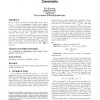Free Online Productivity Tools
i2Speak
i2Symbol
i2OCR
iTex2Img
iWeb2Print
iWeb2Shot
i2Type
iPdf2Split
iPdf2Merge
i2Bopomofo
i2Arabic
i2Style
i2Image
i2PDF
iLatex2Rtf
Sci2ools
DIALM
2008
ACM
2008
ACM
Symmetric range assignment with disjoint MST constraints
If V is a set of n points in the unit square [0, 1]2 , and if R : V + is an assignment of positive real numbers (radii) to to those points, define a graph G(R) as follows: {v, w} is an undirected edge if and only if the Euclidean distance d(v, w) is less than or equal to min(R(v), R(w)). Given 1 and k Z+, let R k be the range assignment that minimizes the function J(R) = P vV R(v) , subject to the constraint that G(R) has at least k edge-disjoint spanning trees. For n random points in [0, 1]2 , the expected value of the optimum, E(J(R k)), is asymptotically (n12 ). This is proved by analyzing a crude approximation algorithm that finds a range assignment Ra k such that the ratio J(Ra k) J(R k ) is bounded. Categories and Subject Descriptors F.2.m [Analysis of Algorithms and Problem Complexity]: Miscellaneous General Terms Algorithms, Performance, Reliability, Theory Keywords Range assignment, probabilistic analysis, approximation algorithm, spanning tree
| Added | 19 Oct 2010 |
| Updated | 19 Oct 2010 |
| Type | Conference |
| Year | 2008 |
| Where | DIALM |
| Authors | Eric Schmutz |
Comments (0)

